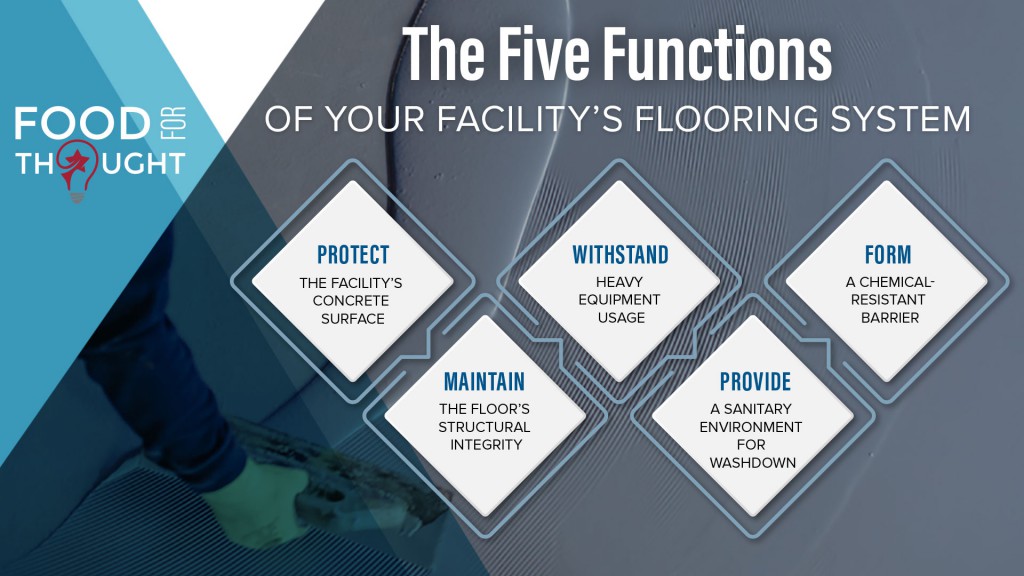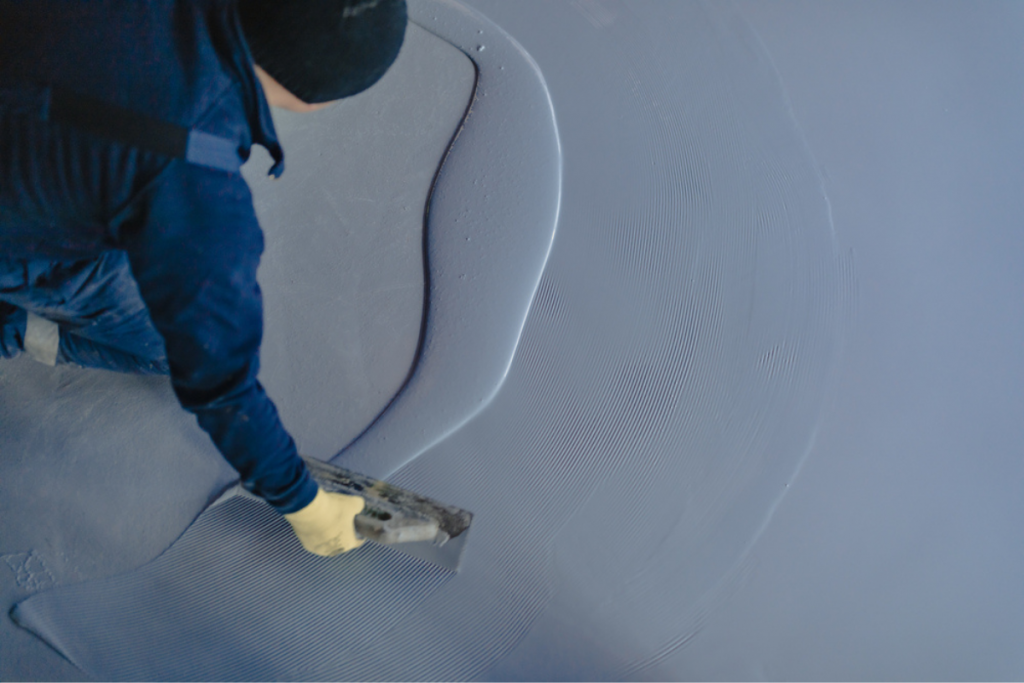The flooring systems in food and beverage processing areas are an essential component of the facility’s daily operation. Whether you’re evaluating flooring in a food production, storage or welfare space, the floor’s cleanability, resilience, durability and surface characteristics are integral to the space’s sanitation and safety.
Selecting the appropriate flooring system for each area is an important and nuanced operational and budgetary decision, especially in a highly regulated industry like food processing. The decision requires careful consideration in the earliest stages of the design and construction process.
Selecting an appropriate flooring system
Your facility’s floors must be able to endure a variety of spills and chemical washdowns, the weight and vibration of heavy equipment, fluctuating temperatures and foot traffic, depending on the application.
Aside from required performance, process area floors, should be non-porous, and be crack-, erosion- and water-resistant, and may require antimicrobial properties to comply with FDA and USDA regulations.

When it comes to flooring materials, there are countless choices to select from, but they are not one-size-fits-all. Your facility’s specific needs and requirements must be taken into consideration.
As you begin to weigh your options, consider these four flooring systems commonly found throughout food plants.
1. Chemical-resistant brick and tile
Food plant owners can choose to install specialty masonry bricks or ceramic tiles with specialized mortars, grouts and setting beds in their processing areas. Chemical-resistant or industrial brick (commonly referred to as “dairy brick”) are designed to resist corrosive conditions and high-impact areas, such as vibration from heavy equipment.
Pros
- Available in varying degrees of resistance to a variety of chemicals, high temperatures, impact, absorption and thermal shock
- Different levels of protection within a space can be readily achieved
- Long service life
- Available in a variety of surface textures
- Aesthetically pleasing appearance
- Repairs can be readily isolated and performed
Cons
- Higher price tag compared to other flooring systems
- Labor intensive installation requiring specially trained installers
- Often requires proprietary products and installation techniques
- High number of joints
2. Resinous flooring
Resinous flooring systems offer plentiful options that meet the unique needs of food and beverage processing. Seamless, monolithic resinous flooring systems are applied as slurries or troweled mortars.
Pros
- Seamless integral bases can be incorporated
- Proprietary systems can be formulated to resist a variety of chemicals, wash down, high temperatures, impact, absorption and thermal shock
- System thickness varies according to requirements, usually greater than 1/8 inches
- Resinous patching and fill materials can be used to build up, patch or create slopes
- The surface can be finished and textured to achieve the desired balance of cleanability and slip resistance in the space
- Different levels of protection within a space can be readily achieved while maintaining a seamless appearance
- Aesthetically pleasing appearance
Cons
- Proprietary systems and products require specially trained installers and technicians for repairs
- Extensive surface preparation is required, including heavily texturing the concrete slab
3. Floor coating
Food manufacturers in search of a durable and economic option can choose to install a fluid-applied coating over a finished structural concrete slab. To maximize the flooring’s lifespan, it’s crucial to ensure the slab is properly cured and prepared before the coating is applied.
Pros
- Coating formulations vary and are selected to address a space’s requirements, including sanitation level, chemical resistance, resilience and durability. Coating thicknesses are usually measured in mils and vary according to requirements.
- Depending on products and conditions, this flooring can be recoated.
- Repairs can be readily isolated and performed.
Cons
- Limited term protection
- May not be suitable for heavy wash down areas
- May not be suitable for high traffic areas
4. Bare concrete
It is possible to finish and texture a structural concrete slab to suit required conditions in different food processing areas. This type of system is normally sealed for dust control and consolidators may be used in new slabs.
Pros
- Least expensive approach
- Requires no specialized installers
- Accelerates construction since no additional preparation is required
Cons
- Tends to be absorptive, offering little protection to slab reinforcement
- Any damage or erosion that occurs will directly affect the structural floor, rather than to a protective covering, which can be difficult to repair
- May not be suitable for ready-to-eat areas
Pro tip: Consult someone with food industry knowledge
Hygiene and sanitation are paramount in the food and beverage industry, regardless of the kind of facility you run. Factors impacting cleanliness, durability and longevity are considerations in each area of your facility, which can be a delicate balancing act.
When selecting a new flooring system or replacing an existing one, you should always consult with a professional who can help you consider your project in its entirety, including drainage, maintenance, workplace and food safety, and USDA and FDA requirements.
As a design-build firm, Stellar can help you navigate the myriad of decisions and selections required on your project from the earliest planning stages to the day you throw the switch to start its operation.
Have questions on which flooring material will provide the best performance in your facility? Email us at foodforthought@stellar.net or give us a call at 800.488.2900.



